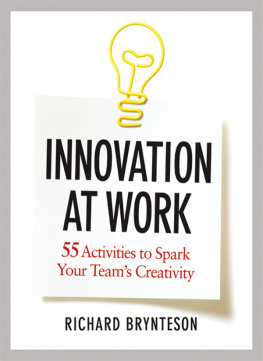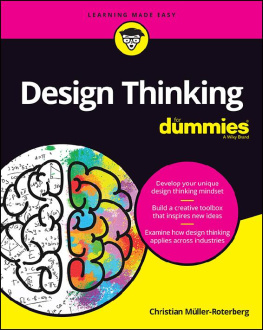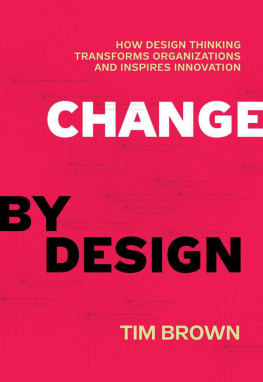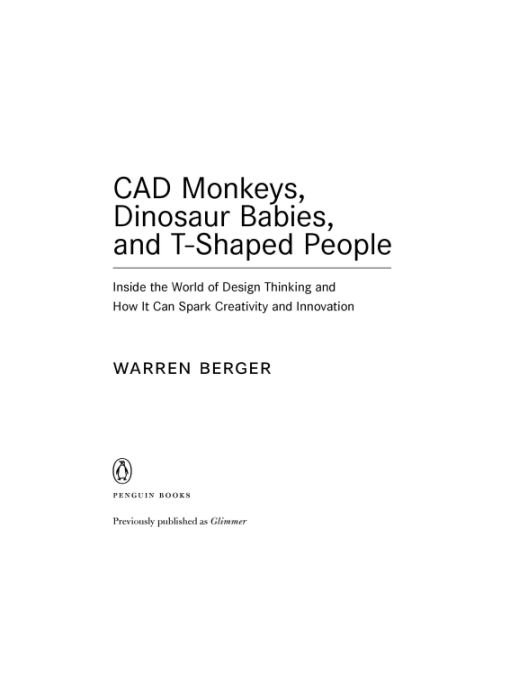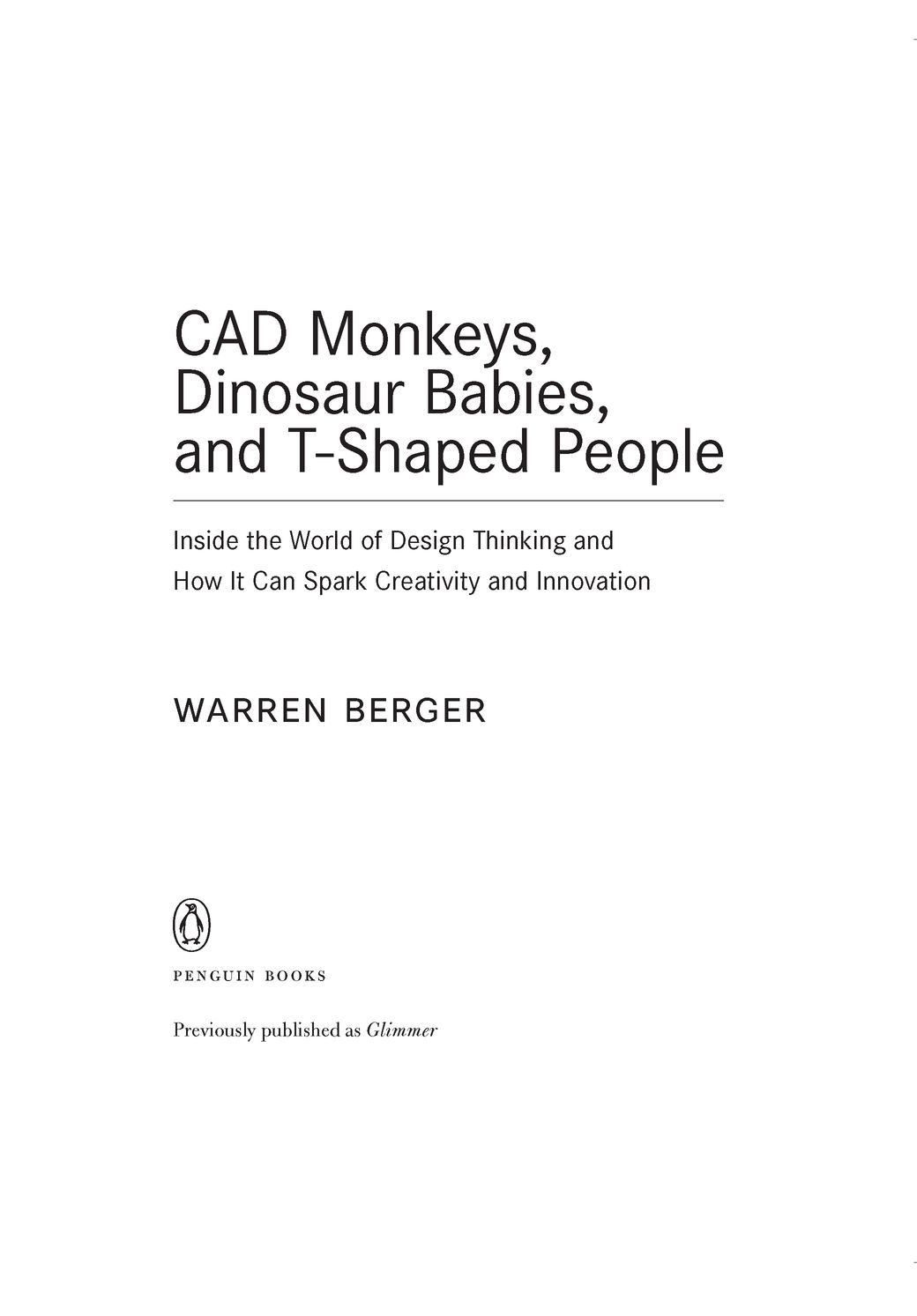Table of Contents
Praise for Warren Bergers CAD Monkeys, Dinosaur Babies, and T-Shaped People
One of the best Innovation and Design books of 2009.
BusinessWeek
In CAD Monkeys, Dinosaur Babies, and T-Shaped People, Berger argues that basic design strategies can be adapted to everyday issuessuch as how to get along with colleagues, how to balance work and life, and how to ease gracefully into old age.
Fast Company
CAD Monkeys, Dinosaur Babies, and T-Shaped People offers marketers insights into modern consumers... and holds inspiration for non-marketers, too, with its accounts of regular folks who had a glimmer momenta sudden vision of the possibleand followed through to create something useful. Berger offers tips to spark such moments.
Psychology Today
Accomplished take on design and those who create it.
Readers Digest
With a gift for storytelling, Berger establishes ten principles that readers can use to spark the glimmer of possibility and potential.
Communication Arts
Bergers book has a relevance not only for people with an interest in design, but for anybody interested in rigorous, analytical thinking and problem solving.
The Irish Times
Berger challenges readers to move beyond the correlation between design and style to associate design with problem solving.
Booklist
Refreshing... eminently readable and breezily informative... has the easy anecdotal style used by Malcolm Gladwell for more than a few blockbusters... Berger has provided the reader context not only to understand, but also to believe that the principles of design can solve problems in the real world.
Core77.com
Explores designs profound, often hidden, influence.
Chicago Tribune
Sheer brilliance. Bergers book is full of pointed anecdotes about how things become easier through design breakthroughs. His larger point is that designers find elegant solutions through questioning what others accept as reality.
Washington Spaces
Its mind-expanding and fun to read ... one of the best books about design Ive read.
TechRevu.com
Extraordinarily well-written... This is the first book about the process of design as practiced at its highest levels, written by an expert journalist for the layperson, that describes exactly how designers think about and view the world.
The Designers Review of Books.com
PENGUIN BOOKS
CAD MONKEYS, DINOSAUR BABIES, AND T-SHAPED PEOPLE
Warren Berger is an award-winning journalist and author who has written for The New York Times Magazine, Wired, GQ, Readers Digest, the Los Angeles Times Magazine, Business 2.0, and New York magazine. His work has appeared in the 2001 Best Business Stories of the Year. He is the author of Advertising Today and Hoopla and the coauthor of Nextville and No Opportunity Wasted. He is also the creator and editor of One, an acclaimed national magazine concentrating on advertising and design.
THE BRIEFING
You have a friend who uses a wheelchair. One day he tells you the three things about that wheelchair he hates: I cant go over curbs, cant get up stairs, and cant look people in the eye when Im talking to them. What would you do to improve your friends wheelchair?
Your grandmother keeps taking your grandfathers prescription pills (and vice versa). You tell them to check the labels on the bottles more carefully. They admit to you that they can barely even read the labels. How can you help them?
Youre designing a laptop computer for kids in the developing world. It cannot cost more than $150. But the parts alone cost more than that. What do you do?
Youd like to get your teenage nephew to stop smoking. While youre at it, youd like to get a million other teenagers to stop smoking, too. Telling them that smoking could kill them just makes it more cool and rebellious. So how do you make nonsmoking cool and rebellious, overnight?
Youre introducing a new automobile in the United States. Unfortunately, nobodys ever heard of this car. And its precisely the opposite of whats been popular in cars lately. And it looks kind of funny. And theres no budget for television commercials. How do you make this car a bestseller?
You find yourself in a village that desperately needs drinking water. Theres a lake just a bike ride away, but the waters foul. How do you bring clean, drinkable water back to the villageusing only your bike?
You always wanted to do something creative and inspirational for a living. But somehow, you ended up operating a dog food company. How do you transform this into a higher calling?
Your country has endured decades of misery brought on by two civil wars and an economy that keeps crashing. You need to turn all that around by creating a new spirit of optimism. Whats your first step?
On the surface, these eight challenges might seem to be unrelated. They range from marketing issues to medical ones, from engineering to advertising, and from ambitious to seemingly impossible. But in each of these instances, the problem at hand was engaged by someone who looked at it in a fresh way and saw a possibilityjust a glimmer, at firstof how things might be done differently. And in each case, that person went through a series of actions, guided by a common set of principles, which were all part of a larger established process. There is a word for that process: design.
When a New Hampshire man envisioned and then created a wheelchair that could stand and walk, he was designing. So, too, was the concerned granddaughter in New York who radically changed the look and shape of confusing medicine bottles, benefiting not just her grandparents but countless others. Principles of design led to the creation of a highly innovative (and irresistibly cute) laptop that rewrote the rules of low-cost computing, and those same principles helped turn the underdog Mini Cooper car into an automotive marketing phenomenon. Quite unexpectedly, design reversed a surge in teen smoking in Florida; in California it yielded a bike that could purify water as it was pedaled. Design enabled a dog food company to find new meaning and success by re-creating itself as an enterprise of, and for, dog lovers. And it was the secret weapon of a Toronto designer who organized a national movement that helped raise morale and productivity in the country of Guatemala.
When we think of design, we dont usually associate it with solving problems such as these. More often, it is equated with style: fashionable clothing or handbags, distinctive typefaces, elegant Philippe Starck furniture or Michael Graves teakettles.
But design is really a way of looking at the world with an eye toward changing it. To do that, a designer must be able to see not just what is, but what might be. And seeing is only the beginning: Designers are also makers. They sketch and build, giving form to ideas. They take that faint glimmer of possibility and make it visible and real to others.
The process designers followwhich blends art and science and is fueled by human empathyis arduous and at times heartbreaking. It is invariably filled with missteps, though each one tends to bring the designer a step closer to getting it right. And when that happens, the result can transform some aspect of the way we live. Suddenly, the act of listening to music, or peeling a potato, or accessing potable water is different, improved. In this way, progress happens by design.



